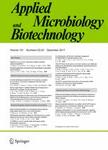版权所有:内蒙古大学图书馆 技术提供:维普资讯• 智图
内蒙古自治区呼和浩特市赛罕区大学西街235号 邮编: 010021

作者机构:Tech Univ Crete Dept Environm Engn Lab Biochem Engn & Environm Biotechnol Chania 73100 Greece GBF Natl Res Ctr Biotechnol Div Microbiol D-38124 Braunschweig Germany Solvay Deutschland GmbH D-30174 Hannover Germany Univ London Imperial Coll Sci Technol & Med Dept Chem Engn & Chem Technol London SW7 2BY England
出 版 物:《APPLIED MICROBIOLOGY AND BIOTECHNOLOGY》 (应用微生物学与生物技术)
年 卷 期:1999年第52卷第6期
页 面:853-862页
核心收录:
学科分类:0710[理学-生物学] 1007[医学-药学(可授医学、理学学位)] 100705[医学-微生物与生化药学] 07[理学] 0836[工学-生物工程] 071005[理学-微生物学] 10[医学]
基 金:European Union Environment and Climate Programme, (ENV4 CT 93-0081) German Ministry of Education, Science and Research, (BEO 0319433 C)
主 题:烯丙化合物/代谢 生物降解 环境 生物膜 生物反应器/微生物学 革兰氏阴性菌/分离和提纯 革兰氏阴性菌/代谢 革兰氏阴性菌/生理学 危害废弃物 工业废弃物 假单胞菌属/分离和提纯 假单胞菌属/代谢 假单胞菌属/生理学 红球菌属/分离和提纯 红球菌属/代谢 红球菌属/生理学 时间因素 水污染物 化学性
摘 要:A bacterial biofilm, capable of mineralising a technical mixture of cis- and tr trans-1,3-dichloropropene (DCPE), was enriched on the biomedium side of an extractive membrane biofilm reactor (EMBR). The membrane separates the biomedium from the industrial waste water, in terms of pH, ionic strength and the concentration of toxic chemicals. The biofilm, attached to a silicone membrane? is able to mineralise DCPE after its diffusion through the membrane. Five bacterial strains with degradation capabilities were isolated from the metabolically active biofilm and further investigated in batch experiments. Two of them, Rhodococcus erythropolis strains EK2 and EK5, can grow with DCPE as the sole carbon source. Pseudomonas sp. EK1 utilises cis-3-chloroallylalcohol and cis-3-chloroacrylic acid, whereas the metabolite trans-3-chloroacrylic acid represents a dead-end product of the pathway of this strain. The other two strains, Delftia sp. EK3 and EK4, although unable to grow with DCPE as the carbon source, can transform DCPE and its upper-pathway intermediates at reasonable conversion rates. They may represent helper functions of the biofilm consortium, which mineralised up to 12.5 mmol DCPE per hour per gram of biomass protein. Higher feed rates in the EMBR (up to 15 mmol per hour per 100-1 bioreactor volume) and shock loads corresponding to concentrations up to 1.8 mmol l(-1) led to a significant increase in the freely floating bacterial biomass in the reactor medium (OD546 = 0.2) At the standard operating feed rate of 1.8 mmol h(-1), the free biomass concentration was very low (OD546 = 0.04).